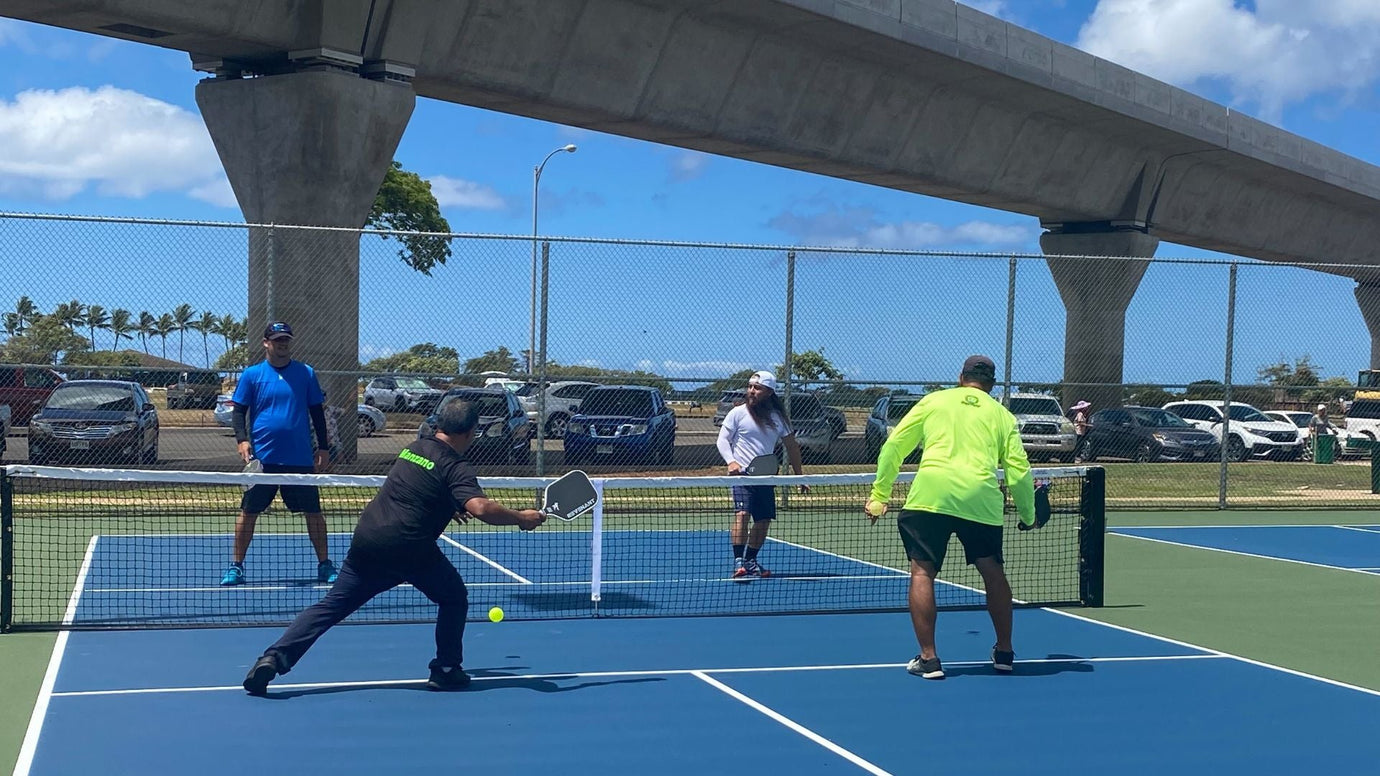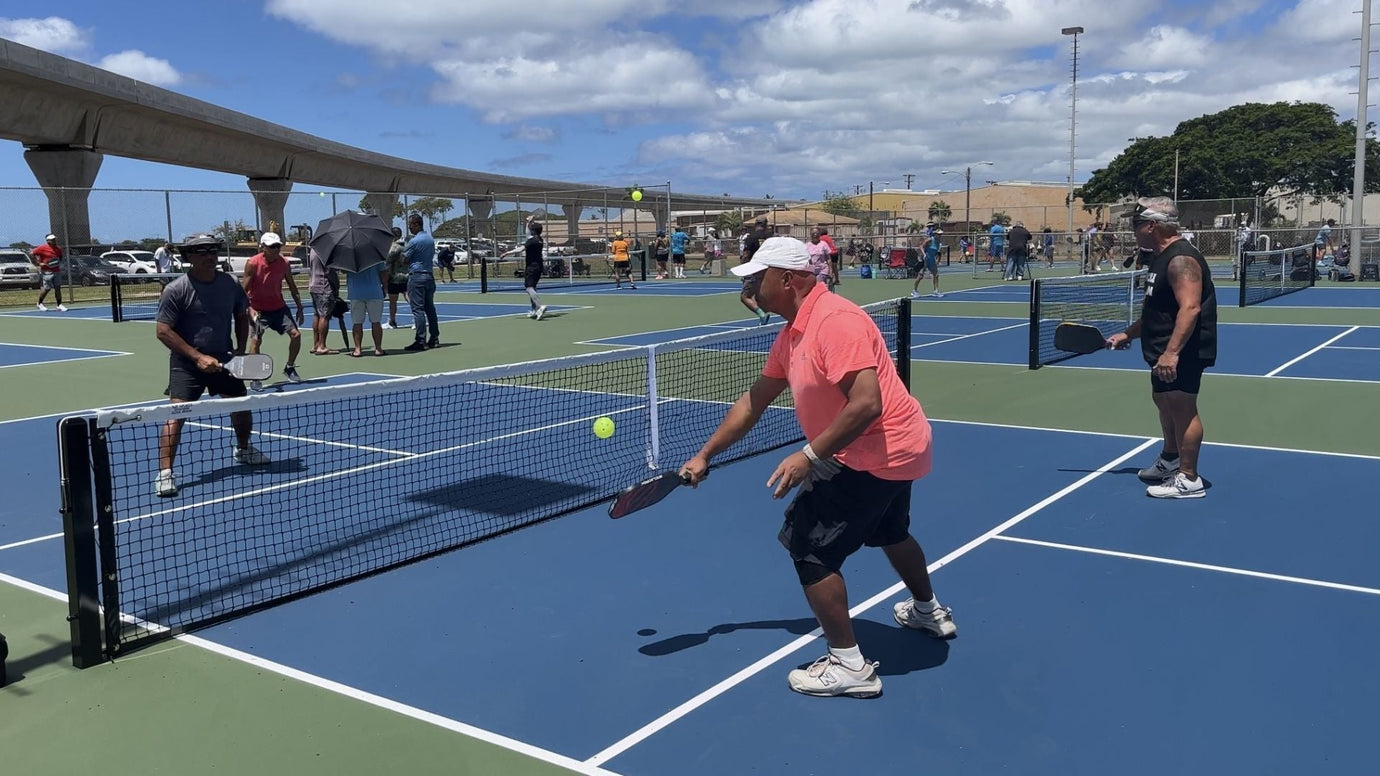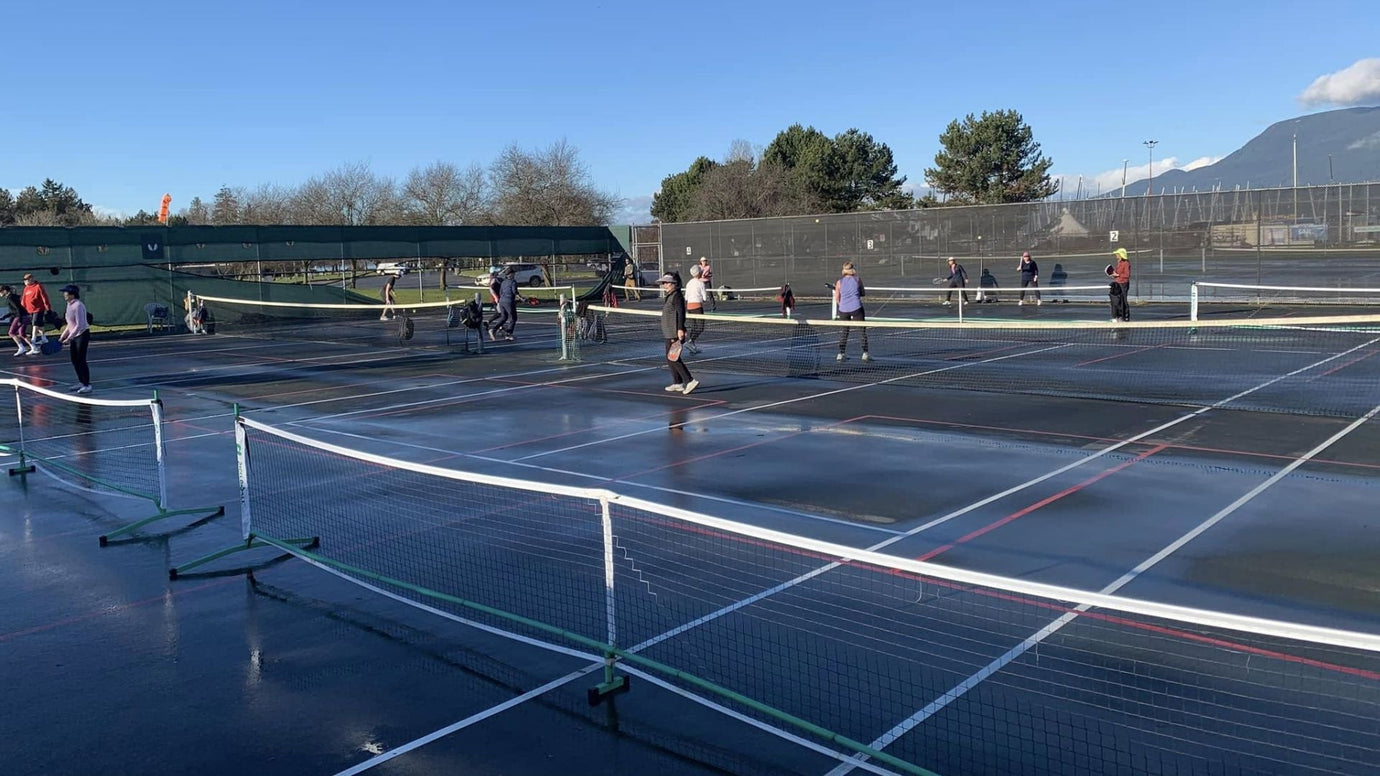Pickleball's meteoric rise continues, and with it, the demand for accessible, high-quality courts. Whether you're a homeowner envisioning a vibrant backyard pickleball court, a community organization planning an upgrade, or a B2B enterprise looking to install multiple facilities, the choice of playing surface is a pivotal decision with long-term implications. Two primary contenders dominate the discussion: traditional pickleball court paint applied to asphalt or concrete, and modern portable pickleball court roll flooring. As a leading manufacturer of innovative pickleball court roll floor solutions , Pickleball Court Co., based in Shenzhen, China, is dedicated to helping you navigate this choice. We aim to clearly illustrate why our advanced roll flooring systems often represent the superior investment in terms of ease, performance, and longevity.
This comprehensive guide will delve deep into a comparison of these two popular surfacing options. We will meticulously examine every facet, from the intricacies of installation and the realities of maintenance to on-court performance and overall cost-effectiveness. We will provide a practical overview of how to paint a pickleball court if you opt for that traditional route, while simultaneously highlighting the compelling, multifaceted advantages of choosing a portable pickleball court system, a solution gaining immense traction for its convenience and quality.
Traditional Pickleball Court Paint: The How-To, The Costs, and The Hurdles
Painting a pickleball court has long been a standard approach, particularly for permanent outdoor installations on asphalt or concrete substrates. This method involves the application of specialized acrylic coatings to create the playing surface and delineate the lines. While seemingly straightforward, the process is laden with complexities and potential pitfalls.
How to Paint a Pickleball Court (The Traditional Method – A Detailed Breakdown):
- Surface Preparation – The Non-Negotiable Foundation: This is unequivocally the most critical, time-consuming, and labor-intensive phase. The integrity of the final painted surface hinges entirely on meticulous preparation. The existing substrate (be it aged asphalt or concrete paint for pickleball court applications) must be rendered impeccably clean. This involves the complete removal of all dirt, dust, grime, mildew, algae, grease, and any loose or flaking material. High-pressure power washing is almost always a prerequisite. Following cleaning, a thorough inspection for surface defects is essential. Any cracks, spalls, holes, or depressions (often referred to as “bird baths” which can collect water) must be expertly repaired using high-quality, compatible patching compounds (e.g., acrylic patch binders). For newly poured concrete, a minimum curing period of 28 days is mandatory before any coatings are applied. Subsequently, the concrete must be acid etched (typically with muriatic or phosphoric acid) to create a porous profile for proper adhesion, or mechanically abraded. An adhesion-promoting primer is then strongly recommended, as detailed by industry experts like SportMaster in their technical specifications. Similarly, new asphalt surfaces require a curing period (generally 14 to 28 days) and will almost certainly need one or more coats of an acrylic resurfacer to fill surface voids and provide a smooth, uniform base for the pickleball court paint.
- Applying Acrylic Resurfacer/Primer: An acrylic resurfacer serves multiple purposes. It helps to create a consistent texture across the entire court, fills minor surface imperfections that may have been missed, and, crucially, promotes better adhesion and uniform coverage for the subsequent color coats. This step is particularly vital for older, more porous, or slightly uneven surfaces. Typically, one or two coats are applied using a soft rubber sport squeegee.
- Color Coating Application – Achieving the Desired Finish: This is where the visual transformation happens. Multiple thin, even coats of specialized pickleball court paint are applied. These are predominantly water-based acrylic coatings, formulated for durability, UV resistance, and slip resistance. They are available in a wide array of pickleball court paint colors, allowing for customization. The paint often contains a specific grade and quantity of fine silica sand to provide the necessary non-slip texture for safe play. Application is almost exclusively done with a soft rubber sport squeegee to ensure even material distribution and the correct film thickness. Each coat must dry thoroughly – a process that can take anywhere from 45 minutes to several hours depending on ambient temperature, humidity, and sun exposure – before the next coat can be applied. Attempting to rush this can lead to blistering, peeling, or an inconsistent finish. Achieving a professional, streak-free, and uniformly textured surface requires considerable skill, experience, and patience. Many pickleball court painting contractors specialize in this.
- Line Painting – Precision is Paramount: Once the final color coats are fully cured (which can take 24-48 hours or more), the pickleball court lines must be laid out with exacting precision according to official USA Pickleball dimensions (20 feet wide by 44 feet long for the playing area). This involves careful measurement and the application of high-quality painter’s tape (often 2 inches wide). To prevent paint from bleeding under the tape and ensure crisp, sharp lines, a specialized line primer or a thin coat of the base color is often applied over the tape edges first. Finally, one or two coats of textured white (or contrasting colored) line paint are applied. Using a pickleball court line painting kit or stencil can aid DIYers, but professional results still demand meticulous attention to detail.
Disadvantages and Costs of Traditional Pickleball Court Paint:
While a freshly painted court can look appealing, this traditional method is fraught with significant drawbacks and ongoing expenses:
- Intensive Labor, Time, and Downtime: The entire process, from initial preparation to final line curing, is lengthy and physically demanding. It’s not uncommon for a court to be out of commission for several days to over a week, especially if weather conditions are not consistently favorable. This downtime can be a major issue for clubs or community facilities.
- Extreme Weather Dependency: The success of a pickleball court painting project is heavily reliant on cooperative weather. Ideal conditions typically involve ambient temperatures above 50°F (10°C) and ideally rising, low humidity, and no rain forecast during application and for at least 24-48 hours post-application. Unexpected rain can completely ruin a fresh paint job, necessitating costly rework.
- Limited Durability and High Maintenance: Painted surfaces, even those applied professionally with high-quality materials, are susceptible to wear and tear. UV exposure leads to fading pickleball court paint colors over time. Freeze-thaw cycles in colder climates can cause cracking and delamination. Heavy play results in abrasion. Consequently, regular pickleball court resurfacing and complete repainting are typically necessary every 3 to 7 years to maintain a safe and aesthetically pleasing playing surface. The cost to paint a pickleball court can range from a few thousand dollars for a DIY job (factoring in a pickleball court paint kit and materials) to $5,000-$10,000+ for professional pickleball court painting contractors, and this is a recurring expense.
- Unforgiving Surface Hardness: Traditional painted asphalt or concrete courts offer minimal shock absorption. This hard, unyielding surface can be tough on players' joints, particularly knees, ankles, and lower backs, potentially leading to increased fatigue, discomfort, and a higher risk of stress-related injuries, especially for older players or those with pre-existing conditions.
- Inflexibility and Permanence: Once a court is painted, it’s a fixed installation. If you need to relocate, repurpose the space for other activities, or if the underlying substrate develops significant issues, addressing the painted surface is a considerable and often costly undertaking. Removing paint is difficult, and simply painting over severe damage is not a viable long-term solution.
- Skill-Dependent and Variable Finish Quality: Achieving a consistently smooth, even, and correctly dimensioned playing surface with paint requires significant experience and specialized equipment. DIY attempts, even with the best pickleball court paint, can often result in an uneven texture, inconsistent color, premature peeling or blistering, or incorrectly measured lines, all of which can negatively impact playability and aesthetics.
- VOCs and Potential Environmental Concerns: While many modern court paints are water-based and have lower VOC (Volatile Organic Compound) content than older formulations, some products may still release VOCs during application and curing, which can be an environmental and health concern, particularly for indoor applications or in poorly ventilated areas.
- Cost of Materials and Labor: The pickleball court paint cost itself is just one component. When factoring in preparation materials (cleaners, etchers, primers, patch compounds), resurfacers, line paint, and potentially the rental or purchase of specialized application tools (like professional-grade squeegees), the material costs for a diy pickleball court paint job can add up. If hiring professionals, labor costs will significantly increase the overall cost to paint pickleball court.
Pickleball Court Co.'s Portable Roll Flooring: The Decidedly Superior Alternative
In stark contrast to the challenges of painted courts, Pickleball Court Co.'s portable pickleball court roll flooring offers a modern, efficient, and player-friendly solution. This innovative approach is rapidly becoming the preferred choice for a diverse range of B2C and B2B clients worldwide.
Unpacking the Overwhelming Advantages of Portable Pickleball Court Roll Flooring:
- Unmatched Ease and Speed of Installation: This is arguably the most significant advantage. Our roll flooring systems are meticulously engineered for incredibly simple, intuitive, and rapid DIY installation. Forget the multi-day, labor-intensive, weather-dependent ordeal of painting. A Pickleball Court Co. portable pickleball court surface can often be laid out, secured, and ready for play in a matter of hours, not days. Our comprehensive and easy-to-follow installation guide empowers individuals and teams to achieve professional results without needing specialized skills or tools. While Pickleball Court Co. focuses on manufacturing and supplying these premium roll floor solutions, we provide you with all the knowledge and support needed to manage the installation process effectively, thereby saving substantial costs on professional installers.
- Minimal Sub-Surface Preparation Required: While a reasonably level and firm underlying base (such as existing concrete, asphalt, a wooden deck, or even a well-compacted grassy area for some portable pickleball court over grass applications) is still beneficial, our roll flooring is significantly more forgiving of minor sub-base imperfections compared to paint, which demands a near-flawless substrate to prevent premature failure.
- Superior Player Safety, Comfort, and Performance: Player well-being is a paramount design consideration for our roll flooring. The advanced materials and construction provide excellent shock absorption and cushioning. This drastically reduces the impact stress on players' knees, ankles, hips, and lower backs, leading to longer, more comfortable play sessions and a demonstrably lower risk of impact-related injuries and long-term joint issues. This is a critical differentiator from the hard, unforgiving nature of traditional painted courts. The surface also offers consistent ball bounce and optimal traction, enhancing the overall quality of play.
- Exceptional Durability and Ultra-Low Maintenance: Manufactured in our state-of-the-art facility in Shenzhen, China, using only high-quality, UV-stabilized, and weather-resistant polymeric materials, our roll flooring is engineered for exceptional durability and longevity. It is designed to resist fading, cracking, peeling, and warping, even under intense daily use and in diverse and challenging climatic conditions, from scorching sun to freezing temperatures. Maintenance is refreshingly minimal – typically involving nothing more than regular sweeping to remove debris or occasional light cleaning with water and mild detergent. There is absolutely no need for the frequent, costly, and time-consuming repainting or resurfacing cycles associated with painted courts.
- True Portability, Modularity, and Unrivaled Versatility: As the name explicitly states, our portable pickleball court flooring systems offer unparalleled flexibility. Need to set up a temporary pickleball court for a tournament, a community event, or a family gathering? Our flooring can be quickly assembled. Want to move your court to a new location on your property or take it with you if you relocate? It can be easily disassembled, transported, and reinstalled. Perhaps you need to repurpose the underlying space for other activities periodically? This is effortlessly achievable with our modular systems. Such versatility is simply unattainable with a permanently painted court.
- Consistent, High-Performance Playing Characteristics: Our factory-engineered surfaces guarantee a consistent and predictable ball bounce, optimal spin response, and reliable traction across the entire court. The precisely engineered texture is specifically designed for pickleball play, offering the perfect balance of grip (to prevent slips) and give (to allow for controlled player movement).
- Enhanced All-Weather Playability: Many of our outdoor pickleball court roll flooring options feature innovative perforated or channeled designs that facilitate excellent water drainage. This allows the court surface to dry much more rapidly after rain or cleaning, significantly reducing downtime and maximizing playing opportunities. These systems are also inherently resistant to damage from freeze-thaw cycles, a common issue for painted courts in colder regions.
- Instant Aesthetic Appeal and Customization Options: Pickleball Court Co. offers a wide variety of vibrant pickleball court colors and attractive design configurations. You can achieve a professional, visually stunning court appearance instantly, without the mess, fumes, and multiple painstaking coats associated with painting. Court lines are often pre-integrated into the modules or can be very easily and precisely applied, ensuring perfect, regulation dimensions every time.
- Superior Long-Term Cost-Effectiveness: While the initial investment for a high-quality roll flooring system might appear comparable to or, in some cases, slightly higher than a basic DIY paint job (though often significantly less than a professionally painted court), the long-term cost-effectiveness of roll flooring is demonstrably superior. When you factor in the substantial savings from eliminating the need for periodic repainting and resurfacing, the drastically reduced maintenance efforts and costs, and the significantly extended functional lifespan of the surface, the overall value proposition of roll flooring becomes exceptionally clear. It’s an investment that pays dividends in both cost and convenience over many years.
- Environmentally Friendlier Choice: Our roll flooring solutions generally involve fewer chemicals, solvents, and VOCs during the installation process compared to traditional court painting methods, making them a more environmentally conscious choice.
Why Choose Pickleball Court Co. for Your Premium Roll Flooring Needs?
As a dedicated and specialized manufacturer, Pickleball Court Co. is laser-focused on designing, producing, and delivering the highest quality pickleball court surfaces available on the market. Our products are the result of extensive research, development, and engineering, all aimed at optimizing performance, maximizing durability, and ensuring player satisfaction. We provide comprehensive pre-sale support, detailed technical guidance, and responsive after-sale service, ensuring you have all the information and assistance needed for a successful installation and many years of unparalleled pickleball enjoyment on your court.
Making the Informed Choice: Traditional Paint vs. Modern Roll Flooring for Your Pickleball Court
The ultimate decision between traditional pickleball court paint and advanced portable pickleball court roll flooring will naturally depend on your unique specific needs, your available budget, and your long-term plans for the court. However, for the vast majority of applications – ranging from the enthusiastic backyard DIYer seeking a temporary pickleball court lines solution to large-scale commercial facilities requiring multiple durable and safe courts – the multifaceted advantages offered by Pickleball Court Co."
's roll flooring are undeniably compelling and often make it the most logical and beneficial choice:
- For the DIY Enthusiast: The sheer ease of installation, coupled with minimal ongoing maintenance, makes roll flooring a far less daunting, more predictable, and ultimately more rewarding project than attempting to achieve a professional-level, long-lasting paint job. No specialized painting skills or equipment are needed.
- For Temporary, Multi-Use, or Rented Spaces: The inherent portability and modularity of roll flooring are simply unmatched. Setting up for an event or in a space that also serves other functions is quick and straightforward. Consider portable pickleball court rental as an option for very short-term needs, but for regular use, owning a roll system is ideal.
- For Prioritizing Player Safety and Comfort: If reducing impact on joints and minimizing injury risk is a key concern (as it should be for all ages and skill levels), then the superior shock absorption provided by quality roll flooring makes it the clear winner over hard painted surfaces.
- For Achieving the Best Long-Term Value and ROI: When considering the total cost of ownership over the typical lifespan of a court, the lower maintenance requirements, the absence of repainting costs, and the greater overall durability of roll flooring translate into significantly better long-term cost-effectiveness and a higher return on your investment.
While painting a pickleball court remains an established method, it is one that comes with considerable trade-offs in terms of labor, ongoing maintenance, performance limitations, and player comfort. Modern portable pickleball court roll flooring systems, such as those expertly manufactured by Pickleball Court Co., provide a demonstrably smarter, safer, more versatile, and ultimately more satisfying surfacing solution for today’s discerning pickleball players and facility owners. Whether you are looking for indoor pickleball court flooring or a robust outdoor pickleball court surface, our roll systems deliver.
Ready to elevate your pickleball experience with a superior court surface? Explore our extensive range of pickleball court roll flooring products , learn more about our pickleball court flooring kit options, or request a free sample today to personally experience the Pickleball Court Co. difference and take the first step towards your perfect pickleball court.
References
- SportMaster - Pickleball Court Paint DIY & Coatings (Details on painting process and materials)
- USA Pickleball - Official Rules and Court Construction (General guidelines for court dimensions and layout) Note: Specific painting techniques are best sourced from paint manufacturers, while roll flooring benefits are often highlighted by specialized flooring providers.







